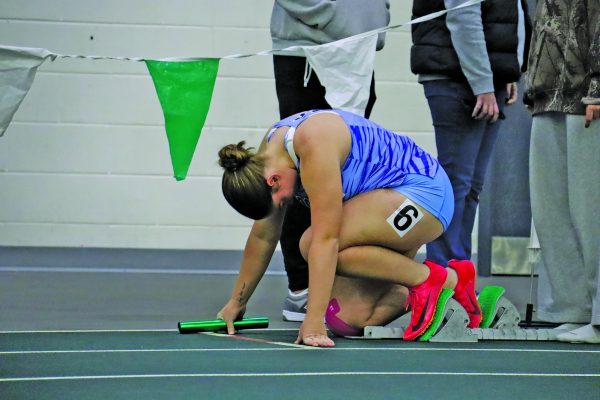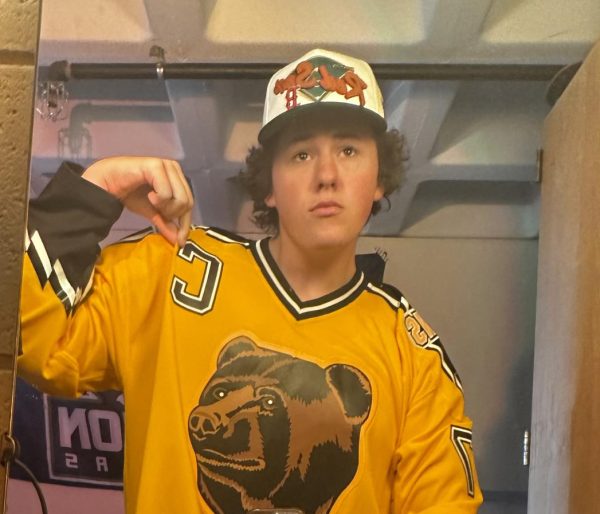Tackling mental health as a student athlete
On March 13, the North Atlantic Conference hosted Victoria Garrick for an online talk about mental health awareness in collegiate sports. Garrick was a starter for the University of Southern California volleyball and gives powerful testimonies on how mental health has played a huge role during her career.
“I do understand the pressure of the lifestyle is what ultimately led to a crisis that changed my life,” said Garrick. “When I first got to USC, I didn’t appreciate the role that the mind played in sports but also in life.”
Garrick spoke about the idea that sports were more important than mental health. A student-athlete has to have a controlled focus on competing first, schoolwork second, and then their mental health.
Garrick attended USC, a Division 1 university, as a walk-on for the Trojan volleyball team. She had to work hard to compete at such a high level while her other teammates had scholarships. Garrick did not believe she would ever start in her first Pac-12 game her freshman year and serve the first play.
Garrick noted that being an athlete is hard, especially at any collegiate level. There is a shift in balance when athletes have to choose what becomes a top priority.
There are so many questions athletes have to ask themselves at the start of a new season. Maintaining a balance between completing classwork, attending practice and taking time for oneself becomes increasingly difficult once a season begins.
“I didn’t really understand what mental health was,” Garrick said. “I also thought, I am an athlete. I’m really strong, I work hard, I’m gritty. Mental health; what does that have to do with me? As privileged as this sounds, and as privileged as it was, I really thought that if I was strong and a leader, I would be somehow immune to having to be affected by mental health.”
According to Athletes for Hope, roughly 30 percent of all college students face mental health issues, and one third of these are student-athletes. When an athlete chooses to compete while in college, they add on an additional load of personal struggles.
“Warm-up was over,” said Garrick. “The National Anthem was sung, the lineup was announced. I found myself starting and playing as a true freshman walk-on at what was the number one team in the country in 2015. We went on to win the next 23 games, but slowly, as things went on, my new life intensified. It started to sink in what it entailed to be a student-athlete.”
Garrick noted the early morning practices and the long road trips provided a chance to do homework or to catch up on sleep. Sports become the priority over class work. The feeling of becoming overwhelmed finally sinks an athlete into a hole of desperation as they struggle to make it through the rest of the season.
The team has to rely on the fact that each person is fully dedicated to participating to their fullest potential. If one person is not focused during a game or practice, it can bring the whole team down.
Adding to the problem are societal pressures that can affect how athletes view themselves. Getting to play at the collegiate level is a lifetime goal for student-athletes. There is no “I” in the word team. The athlete is representing their college and has to work hard to respect the idea that they are not playing for themselves.
Each team and division is different. There are always a strict number of rules athletes must comply with. For Garrick, she played in the hardest conference for women’s volleyball in Division 1. The pressure of playing on the greatest volleyball team in the country at the time initiated a new level of personal struggles.
“My new life had intensified,” said Garrick. “It really started to sink in for me what it entailed to be a student-athlete. The first thing that I can remember that negatively impacted me were our team rules.
“If you broke a rule, the entire team had to run at 6 a.m. We always had to wear the same color shirt, you could not be late. You could not be a minute late, and it didn’t matter if it was from class or tutoring.”
These rules might seem outlandish for student-athletes that play for lower-division schools, as their rules may not be as strict. Garrick started to struggle to keep up with team rules and playing for her team
She developed an eating disorder, performance anxiety, and found it hard to reach out to someone about her mental health issues. In her sophomore year, she began to talk about her battle with anxiety and depression. In 2017, Garrick took the TedTalk stage to give her first public talk on mental health and collegiate athletics.
In 2020, Garrick went on a national college tour speaking to over 15 colleges. Garrick is the Founder and CEO of The Hidden Opponent, a non-profit advocacy group that helps to raise awareness of student-athletes’ mental health to help beat the stigma in sports culture. She has a Youtube channel with videos about her mental health struggles and time as a student-athlete.
The NAC had a successful turnout with over fifty student-athletes from across the conference. Many students asked Garrick questions about how they should get help if they were facing the same issues.
She made it a point multiple times to always reach out to a coach, athletic trainer, or mental health counselor to get the help immediately. No one, she stressed, should have to struggle alone.

Senior, Pre-Law & Journalism
Grew up in Middle Town, NY
Fall 2019 - Present
My spirit animal is a Narwhal because they are the aquatic unicorns!






